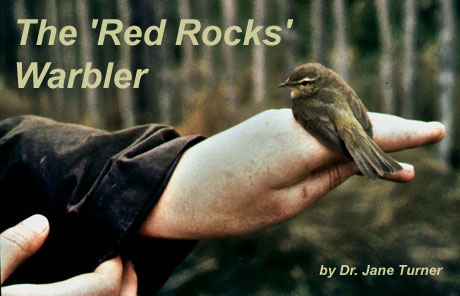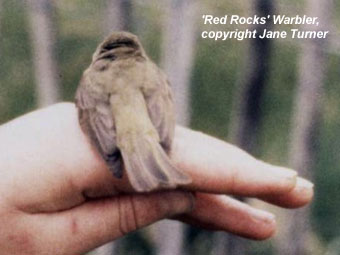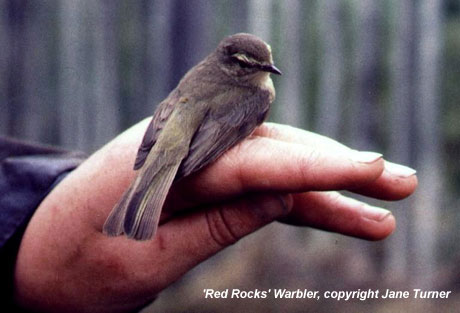
Before I start I should make clear that this bird is at present officially unidentified, though I have some strong suspicions!
It was found in a mist net, early on the morning of April 29th 1990, at Red Rocks Marsh, Hoylake, Merseyside. As I took it out I recall thinking that it was distinctly odd, showing a combination of colouring and structure that didn't seen to fit anything in particular. It felt like a Chiffchaff but certainly did not look like one. To non-ringers, it is strangely possible to detect a difference between e.g. Willow Warbler and Chiffchaff by touch!
Closer examination in the hand showed that the wing formula was compatible with Chiffchaff, though the emargination on the 6th primary was a little weaker than usual and the 5th primary was a little shorter and the primary projection a little greater than typical. The wing length was 59mm. While it sort of fitted Common Chiffchaff on structure, the plumage did not. It was an extremely abraded bird, with a suspended moult, which no doubt confused things further. There was one fresh greater covert and two fresh retrices.
 The upperparts were tinged distinctly green, the same tone as a green Barbour jacket, the rump was distinctly paler and cleaner green, reminiscent of Bonelli's Warbler.
The upperparts were tinged distinctly green, the same tone as a green Barbour jacket, the rump was distinctly paler and cleaner green, reminiscent of Bonelli's Warbler.
The yellowy 'supers' were very prominent and strongly bridging, like a Greenish Warbler, but were too short and the one fresh greater covert, while edged bright yellowy-green, did not have the kind of tip to it that would have formed a wing-bar if repeated across the rest.

The throat was finely streaked primrose yellow, as were the under-tail coverts. The flanks were also slightly yellowy and the rest of the underparts were white. The legs were not noticeably different in colour than a Willow Warbler caught at the same time. We thought that is was most probably a Chiffchaff of the race brehmii.
We decided to let the bird go and see if observing it in the field would help with the identification; jizz in the hand is not easy! Fortunately the bird hung around for the rest of the morning, quite an exceptional happening for Red Rocks and showed really well. At first it was quite restrained, presumably recovering from the indignity of being handled, but then it started to move about and feed. It was an inveterate tail-pumper, just like standard 'Chiffs', and apart from possibly looking a little bit longer-tailed, could have passed off as Chiffchaff quite easily if it wasn't for the plumage features described above, especially the 'supers', and the calls it was making. To me it sounded very like an abientinus Chiffchaff, without the inflexion of a standard Chiffchaff, so more "peee" than "houee". The only difference I noted was a slightly more buzzy tone than a classic pleeper! Then the bird started singing incredibly loudly. The best I can describe it as is Tsiff, Tsiff, Tsip, Tsiff, psis-psis-psis-psis-psis-psis-psis-psis. The first notes were close to the Chiff of Chiffchaff song, slow, with gaps between then, and on one note. The second part of the song was fast, and descending very slightly in pitch. Sometimes it just did the second part, sounding most like a Wood Warbler, it even quivered like a Wood Warbler.
This was how I expected an Iberian Chiffchaff to sound! We were enjoying an extended period of good overshoot weather e.g. the day before we had seen a Bee-eater and a Bluethroat, which were pretty remarkable for Merseyside! Perhaps more astoundingly we trapped three more birds that showed similar characteristics to this individual (without the abrasion and suspended moult) over the next few days, two of which gave the same call in the field but none of which sang.
Of course at the time Iberian Chiffchaff was not recognised as a species. We did not record the bird's song, which looks like a pretty stupid move now, since the BBRC are only considering sound recorded records.
Postscipt
Having seen the comments appearing on the Surfbird site, I have to admit that I did not consider Radde's Warbler at all at the time - it was just too green and yellow, and I was on the west coast in spring. I guess the greenness of the bird does not come out too well in the scanned images, but notice the edges of the fresh tail feathers. I did have a serious go for Greenish and even Yellow-streaked Warbler though! Competent birders have also suggested Green Warbler and Tytler's Warbler when deprived of the context of the record. No one as yet has suggested a hybrid, which remains my nagging doubt. If I could go back in time, I'd take a blood sample in addition to better notes, better photographs and a sound recording!
Comments and views are most welcome! Does anyone have good criteria for field id on non-singing putative Iberian Chiffchaffs and did anyone else on the West Coast come across any funny looking Chiffchaffs that spring?
Dr J.E.Turner, TurnersHBO@aol.com